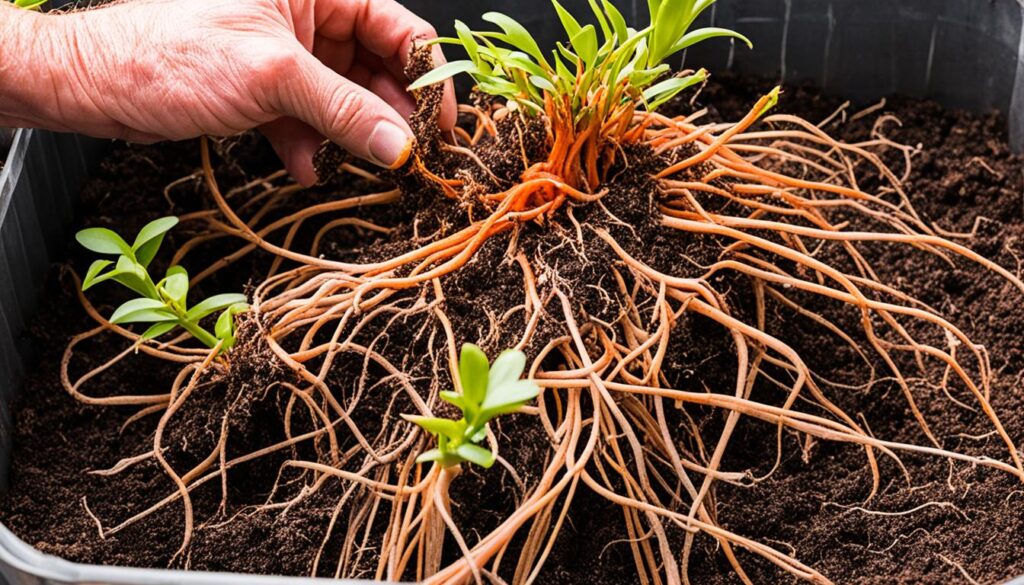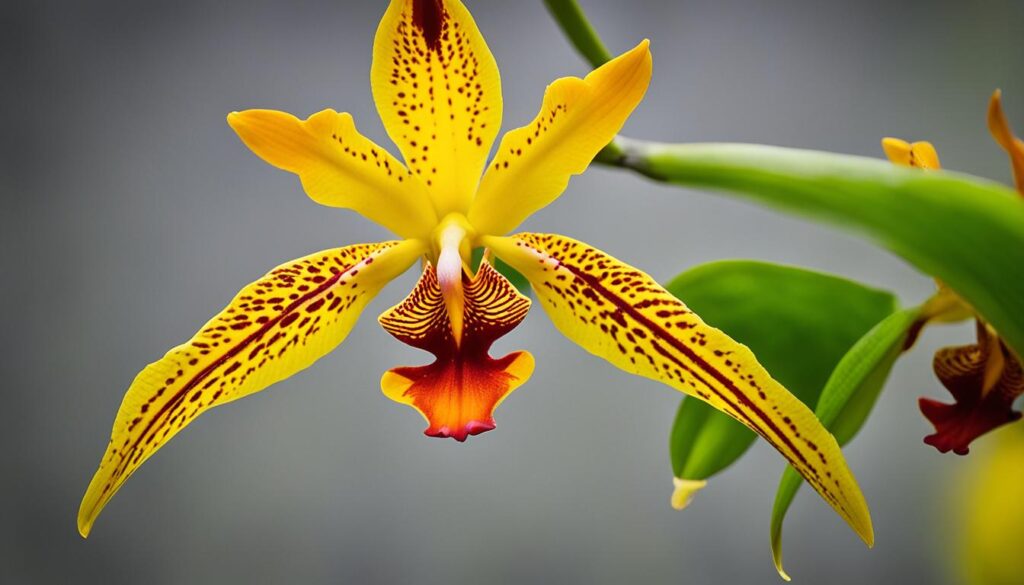Psychopsis orchid, also known as the butterfly orchids, flutter into the spotlight, not just with vibrant colors and stunning forms, but with their astonishing ability to imitate the creatures around them.
Quick Facts
| Characteristic | Detail |
|---|---|
| Countries of Origin | Central and South America, particularly from Trinidad to Peru and Brazil |
| Colors | Primarily yellow and brown with distinctive markings, often a butterfly-like appearance |
| Size | Medium; long inflorescences can reach up to 2 feet with single flowers opening successively |
| Difficulty To Grow | Moderate; requires attention to watering and light but is relatively adaptable |
| Bloom Season | Can bloom year-round under optimal conditions; flowers last several weeks and open successively |
| Light Requirements | Medium to high; bright, indirect light preferred |
| Watering Needs | Consistent moisture needed but must dry slightly between waterings |
| Temperature Range | Warm; prefers temperatures between 65°F and 85°F (18°C to 29°C) |
| Potting Medium | Well-draining; a mix of bark and perlite or sphagnum moss works well |
| Propagation Methods | Division of clumps; very slow to propagate from seed |
| Common Pests and Diseases | Susceptible to scale, mealybugs, and fungal infections like other orchids |
| Fragrance | Generally not fragrant |
| Lifespan/Longevity | Long-lived; individual plants can bloom for many years with proper care |
| Conservation Status | Not widely considered endangered but may be threatened by habitat loss in specific areas |
| Unique Features | Notable for its striking, butterfly-like flowers and the ability to bloom on the same spike for years |
My interest in these mimicry wonders was piqued by the legendary David Attenborough and his series “The Private Life of Plants.” He introduced many, including myself, to these extraordinary plants that stand out for their ingenuity in the kingdom of flora.
It’s hard to overlook the wonder of Psychopsis orchids when you gaze upon their petals that sway with such imitation that they could be mistaken for a group of carefree butterflies dancing in the air.
Their allure goes beyond the surface; it’s in the science and secret behind these orchids that really draws us in.
Camouflaging as a defense mechanism or a way to lure in pollinators, these flowers illustrate evolution’s creativity at its finest.
Each time I come across Psychopsis orchids, I am swept away by the intricacies and the subtle, nearly playful, aspects of nature’s design.
And now, I desire to bring you into my world, to witness the marvelous beauty of these beings that could easily be the envy of any masterful painting.
Key Takeaways
- Psychopsis orchids, boasting over 26,000 varieties, are a visual spectacle in the orchid family.
- Their butterfly-like appearance showcases nature’s capacity for astonishing mimicry wonders.
- These captivating orchids extend beyond just beauty, acting as clever imposters in the pollination game.
- Understanding and appreciating these plants grow from the insights of renowned naturalists like David Attenborough.
- Psychopsis orchids have developed unique survival strategies that reflect nature’s complex artistry.
Discovering the Unique Beauty of Psychopsis Orchids
As I delved into the world of orchid allure, I realized that the Psychopsis orchid is one of nature’s marvels, delighting us with its mimicry and enticing displays.
The enchantment begins with the orchid’s tricks—luring in pollinators with an uncanny resemblance to other insects and creatures.
This fascinating adaptation is crucial to their survival and part of what makes them so intriguing to botanists and enthusiasts alike.
The Fascinating Mimicry of Psychopsis Orchids
While watching Attenborough’s series, I was captivated by how orchid mimicry serves as a sophisticated strategy within the ecosystem.
Particularly, the Psychopsis species have perfected the art of deception, their exotic blooms resembling creatures right from a fantasy world, enticing, deceiving yet utterly necessary for their pollination saga.
Understanding the Diversity: Psychopsis Orchid Varieties
I’m always amazed by the wide range of orchids out there, and Psychopsis varieties are no exception.
Their names, inspired by the very beings they mimic, such as the spider, bee, and butterfly orchids, reflect the diversity within this fascinating genus.
Each one has adapted uniquely to its environment, boasting a plethora of shapes and colors that contribute to the emotional pull these plants have on us.
Exploring the Habitat of Psychopsis Orchids
Discovering the natural environments where Psychopsis orchids thrive is just as exciting as the species itself.
Originating from the rainforests of New Guinea and other tropical regions, these orchids flourish in conditions of high humidity and warm temperatures, characteristics emblematic of their natural habitat.
However, the delicate ecosystems that support these plants are under threat, underscoring the need to appreciate and protect these natural treasures.
| Psychopsis Orchid Variety | Visual Mimicry | Typical Habitat |
|---|---|---|
| Psychopsis papilio (Butterfly Orchid) | Resembles a resting butterfly | Tropical rainforests with high humidity |
| Psychopsis sanderae (Bee Orchid) | Mimics the appearance of a bee | Warm, moist environments with dappled light |
| Psychopsis kramerianum (Leprechaun Orchid) | Lures insects with its bright, bug-like patterns | Areas of indirect sunlight and stable temperature |
How to Grow Psychopsis Orchids Successfully

As someone who loves the unique beauty of Psychopsis orchids, I’m here to share my essential care tips for Psychopsis orchids to help fellow enthusiasts understand how to grow Psychopsis orchids in their own homes.
Achieving the best conditions for Psychopsis orchids is all about mimicking their natural tropic backdrop – here’s how I do it.
First off, temperature control is crucial. I maintain daytime temperatures between 65-85°F and ensure it drops to a comfy 55-60°F at night for optimal growth.
It’s kind of like giving them a taste of their native warm days and cooler evenings, perfect for their development.
High humidity is another box to tick, keeping it consistent at 50-70%. Trust me, these orchids love to bask in moisture just like they would in their humid rainforest homes.
I use a humidity tray or a room humidifier to make sure they’re getting the misty conditions they thrive in.
Now, let’s not forget lighting. Bright, indirect light is the way to go. I place them in a space where they get plenty of light but avoid direct sun rays that can harm them. A sheer curtain works wonders for me to filter the light just right.
When it comes to watering, “regular” is the keyword. I’ve learned to check the top inch of the potting mix; if it’s dry, it’s time to water.
Plus, during the growing season in spring and summer, I feed my orchids with balanced orchid fertilizer biweekly to support their vigorous growth.
- Maintain warm daytime and cooler nighttime temperatures
- Ensure consistent high humidity
- Provide bright, indirect light
- Water regularly and fertilize biweekly in spring/summer
By following these simple yet effective guidelines, you too can experience the joy of nurturing Psychopsis orchids to their full potential. Happy growing!
Unveiling the Intriguing Psychopsis Orchid Bloom Cycle
As a lover of these extraordinary plants, understanding the Psychopsis orchid bloom cycle is key to experiencing the joy of their vibrant blooms.
These orchids are not only stunning but temperamental bloomers, requesting nothing less than perfect harmony of care to showcase their flowers.

Inducing Blooms in Your Psychopsis Orchids
If you’ve been following a psychopsis orchid care guide, you’re likely familiar with their need for suddenly plunging nighttime temperatures to initiate the blooming process.
But that’s not all. I make sure to follow a regimented schedule of psychopsis orchid watering, ensuring the roots get neither too much nor too little moisture.
It’s a balance that can take time to perfect, but the results are more than worth the effort once those blooms appear.
Longevity and Reblooming of Psychopsis Orchid Flowers
And what about after the blooms? The celebration doesn’t end. The longevity of orchid flowers can be extended with proper care, including positioning them away from direct sunlight.
I’ve managed to get my psychopsis orchids to rebloom, reflecting the joy of their presence in my home even longer. The satisfaction of reblooming psychopsis orchids is something every grower should experience.
Think about it, this single plant can live with you for over a decade!
| Condition | Importance to Bloom Cycle | Action to Encourage Blooms |
|---|---|---|
| Bright Light | Essential for bloom initiation | Avoid direct sun; use sheer curtains or similar to filter light |
| Temperature | Critical for blooming phase triggering | Provide a nightly drop of 10-15 degrees |
| Watering | Important to maintain moisture without waterlogging | Water consistently when the surface is slightly dry to the touch |
| Fertilizing | Necessary for optimal growth and bloom development | Use balanced orchid fertilizer every two weeks during growth season |
The magic of these natural wonders is there for us to encounter, in all its glory.
Watching my psychopsis orchid go from a shy plant to a blooming marvel fills me with a sense of accomplishment and pride.
It’s a testament to the care and dedication we, as orchid enthusiasts, are so willing to give.
Conclusion
When I set out to explore the wondrous world of Psychopsis orchids, I didn’t realize just how captivating these plants could be.
It’s not just about their beauty, but also their incredible mimicry talents and the diverse array of shapes and colors these orchids can take.
If you’re like me and find these aspects intriguing, you might consider adding a Psychopsis orchid to your plant collection.
They’re not your average houseplant, and they do come with a unique set of care requirements, such as the right warmth, humidity, and light.
But trust me, it’s worth it.
What’s especially rewarding about these orchids is their longevity. With proper care, they’re a gift that keeps on giving.
The process of repotting Psychopsis orchids can be a bit nerve-wracking at first, given their delicate roots and specific soil needs.
However, once you get the hang of it, it’s a smooth process that ensures the health and growth of your orchid.
And let me tell you, seeing those blooms reappear is a joyful experience that feels like a personal achievement every single time.
Every one of the Psychopsis orchid varieties brings its own flavor to the mix.
Whether you’re drawn to the butterfly orchid’s striking look or the spider orchid’s unusual sense, there’s a Psychopsis for every taste.
I can’t help but be in awe of the natural artistry of these plants, a clear reminder of nature’s ingenuity.
Nurturing them might be a bit of a challenge, but it’s a worthwhile endeavor that adds a splash of nature’s marvels right into your living space.


Leave a Reply